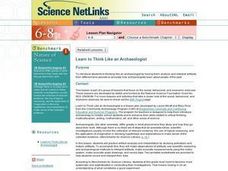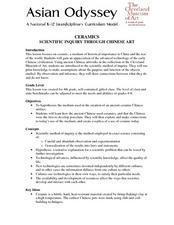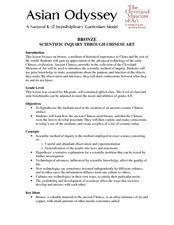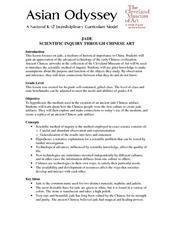Curated OER
Artifacts 1: What Can We Learn From Artifacts?
Sixth graders are introduced to artifacts and explore an online archaeological site to connect clues about how people once lived. In this deductive reasoning lesson, 6th graders participate in the stratigraphy game on Kids Dig Reed.com...
University of California
Religious Influences
While the Roman empire often conjures up images of soldiers and emperors, its culture was more complex. Using primary sources, including ancient historians and pictures of artifacts, pupils consider the religious influences on Roman...
Curated OER
Early Civilizations
Sixth graders examine the characteristics of early civilizations. After reading a story, they discuss the photographs of Egyptian peasants and try to determine what the detectives in the story are looking for. They play the role of...
Curated OER
Pharaoh Phonetics
Students explore ancient Egypt. In this Egypt lesson, students use the Internet to research ancient Egypt and then participate in several activities that help them better understand Egyptian culture.
Curated OER
Ancient Mediterranean Trade Fair
Sixth graders begin the instructional activity by discussing how artifacts are located. In groups, they define the terms supply, demand, resources and trade and discuss how the United States is affected by International trade. They use...
Curated OER
Ancient Cyprus: The Cesnola Collection at the Semitic Museum, Harvard University
Ninth graders review what they already know about ancient civilizations. Before visiting the museum, they complete a pre-test on Cyprus and how trade is important to the island. During the visit, they travel in small groups to examine...
Curated OER
The First Farmers
Learners investigate how constant irrigation, with repeated evaporation of water eventually ruined farm land in southern Mesopotamia. They discuss the development of irrigation.
Curated OER
Relative Dating in Archaeology
Students create a timeline that explains how ancient cultures used artifacts. In this Relative Dating in Archaeology lesson, students examine artifacts and draw conclusions about their origins. Then students analyze antiquated objects or...
Curated OER
Teaching About Trade in the Ancient Mediterranean
Sixth graders examine the trade routes in the Mediterranean of the Ancient world. In groups, they view slides of artifacts while answering questions on a worksheet. After watching a video, they discuss how each object was found and...
Curated OER
Cargoes from Three Continents Ancient Mediterranean Trade
Sixth graders begin the lesson by researching the different types of ships and shipbuilding techniques used to help trade in the Mediterranean Sea. Using different objects, they determine what one can tell about a society and discuss...
Curated OER
Leaarn to Think Like an Archaeologist
Young scholars examine how to act as archaeologists by examining artifacts. The inquiry is meant to teach learners about analysis of ancient civilizations and scientific finds. Fossil evidence is also covered to make connection to the...
Curated OER
The Four Corners Region of the United States Cultures, Ruins and Landmarks
Students who live in the inner city are introduced to the four corners region of the United States. In groups, they examine how the region differs compared to where they live and their culture. They develop maps of the area and locate...
Curated OER
Ceramics Scientific Inquiry Through Chinese Art
Fourth graders explore, examine and study ceramics, a medium of historical importance to China. They review the advanced technology of the early Chinese civilization and are introduced to the scientific method of inquiry and make...
Curated OER
Using Evidence from a Shipwreck to Explore Late Bronze Age Trade in the Mediterranean
Students examine a shipwreck from the late Bronze Age. As a class, they view a variety of slides to describe the cargo and examine the artifacts found on the wreckage. They discuss what each object tells them about the crew and the time...
Ocean Explorer
Looking for Clues
Upper graders become "shipwreck detectives" by studying the debris field from a shipwreck in the Aegean Sea which took place in the 700s. A website is accessed that gives specific information about the debris field, and pairs of...
Curated OER
Look At Those Leaves!
Students collect, observe, sort, and measure leaves. In this leaf lesson, students take a walk to collect leaves. They bring the leaves back into the classroom to observe, sort, and measure them. They visit a website to learn more about...
Curated OER
Exhibition: Nathan Oliveira
High schoolers examine the life and works of Nathan Oliveira. In groups, they discuss his influences on the type of art he made and how his emotions are reflected in his artwork. They also note the characteristics of each section of the...
Curated OER
Bronze: Scientific Inquiry through Chinese Art
Learners examine the use of bronze and porcelain in Chinese art and commerce through in-class activities, role play events, and small-group discussions in this exciting Social Studies/Arts lesson.
Curated OER
Jade: Scientific Inquiry Through Chinese Art
Young scholars discover the uses of Jade in Chinese art and society through in-class discussions, group projects, and internet research. Additional enrichment activities are included.




















